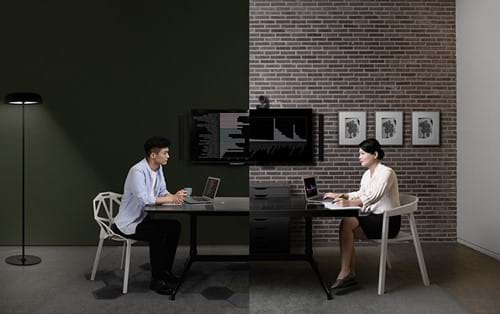83% of Professionals Depend on Technology for Remote Work

Where would we have been without technology these past six months? It has enabled an unprecedented volume of remote collaboration and working from home. And it isn’t changing any time soon.
According to ‘7 Steps to Improve Virtual Meetings in the New Era of Work’’, a new paper by consulting and research firm Frost & Sullivan, “Transitions between working from the office and at home will be ongoing and fluid for many professionals.”
This is borne out by a survey finding from Microsoft, which states that 71% of employees and managers desire to continue working from home at least part-time. At the outbreak of the pandemic, there was a rush to make this happen, in any way possible. Now, however, in the knowledge that remote and distributed working are here to stay at one level or another, Frost & Sullivan (F&S) assert, “Remote participants should not be at a disadvantage – they need to hear and be heard within the conversation.”
Shift to Remote Work
In their new paper, F&S dig deeper into the work-from-home landscape and the role of virtual communication in it. They reveal some interesting facts and figures. For example, before the pandemic, just 2% of the global call center agent population worked from home. One can only imagine how that figure has soared in the past few months. And what about post COVID-19? Estimates suggest that while not remaining at the current peak level, at least 15% of call center agents will continue to work from home.
Beyond call center agents, the percentage of office workers based at home shot up from around 5% before the pandemic to 50%. F&S claim that this number is expected to return to around 25-30% post COVID-19, significantly higher than at the start of the year.
Understandably, this will have an impact on organization’s investment in the equipment it needs to keep its teams communicating and productive. F&S continue, “The importance of equipment, such as headphones and earphones with built-in microphones, will become even more prevalent for the larger than ever work-from-home segment, so should be considered in a company’s overall virtual conferencing plan.”
High Quality Audio Conferencing – seamlessly delivered
They themselves needed to deliver flawless audio must also be up to the new task. This is especially so when you consider that the average duration of a meeting is now between 31 to 60 minutes – up 10% in the last 15 years. Poor audio over the course of an hour-long meeting is frustrating and makes a significant impact on participants’ productivity. The answer? High quality audio in meeting rooms. This should be able to filter out background noise and enhance focus; decrease errors due to miscommunication; reduce the need to repeat information; lessen participant fatigue and frustration; integrate remote participants fully into discussions; and shorten meeting length, while reducing cost.
Many organizations are already heading along this route. 83% of professionals say they depend on technology to conduct meetings and collaborate. But the ad-hoc purchase and placement of generic speakers, microphones and other audio equipment typically delivers only “good enough” audio performance, not flawless.
Frost & Sullivan argue that to optimize audio performance in rooms connected to any conferencing service and to remote-working colleagues, technology investment stakeholders must emphasize standardization on certified audio devices as a high priority. This will also help to streamline room audio management and drive user adoption.

Related Posts
Part 2: Sound of Satisfaction: How High-Quality Audio Enhances Employee Experience
Unleash employee satisfaction with high-quality audio. Enhance productivity, engagement, and workplace happiness through superior sound technology.
Circle of Frustration Video
Optimize productivity and morale by investing in quality audio solutions, enhancing communication, and breaking frustration cycles for both in-office and remote teams.